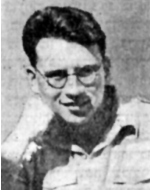Kleiman, Yosef
Son of Trude and Emil, was born on July 23, 1914 in Berlin, the capital of Germany, to an advanced Zionist family. He was a member of the Habonim youth movement in Germany and later joined the He – Chaluts movement. After mental agitation, he decided to stop his studies at the university and went on a pioneering training program in Latvia. He willingly adapted to the conditions of the training and concentrated all his German friends around him. He stood out in his personality and gained general trust. Although German immigrants were a minority among the members, Yosef was elected as secretary of the hachshara. He was a good friend and many used to turn to him in times of trouble. In preparation for the aliya, he went with the Shalsheles group to a preparatory camp near Munich, where he was also the center of the group. At his suggestion, the members went out to work in the surrounding fields, to show the goyim what a pioneer was. His parents asked him to come with them to Israel and assist them in establishing their rehabilitation, but he saw a need and an obligation to continue to work among his group. Joseph immigrated to Israel on October 15, 1934 and joined Kibbutz Givat Hashlosha. From there he moved with the Shalshelet group to Afikim. Later, the group joined the “Betlem” kibbutz, which was in the Nahalat Yehuda district, and served for a certain period as the group secretary. Afterward, he moved with his friends to the Kinneret Courtyard, where they concentrated before they went to settle in Ein Gev. Joseph was one of the first settlers in Ein Gev and lived there for almost 11 years. He stood up to all the difficulties of the young economy and invested all his organizational abilities in developing it. He held many positions in the economy, was the Labor Center, secretary of 1939 (1940), worked in fishing and more. He always encouraged his friends and demanded patience. Yosef studied at the seminary and in the last two years of his life was a teacher in Ein Gev. In this work he was satisfied and found the mixture between working life in the village and his strong desire to study. He served as a model for children, youth and friends. He was a member of the Haganah for many years. In 1942-1943 he served as the organization’s cultural officer in the Sharon region. During the War of Independence, a few months before the invasion of the Arab states, he underwent training and was promoted to the rank of platoon commander and commander during the shelling and took a significant part in the defense of the economy. On June 11, 1948, a shell hit him while standing at the observation post in the section he was responsible for and died shortly afterward. He left a wife, Shulamit, and a daughter. He was first buried in Tiberias and was later transferred to the eternal rest of the cemetery at Ein Gev
